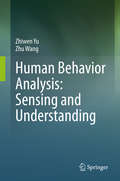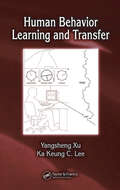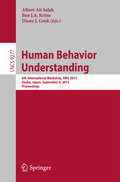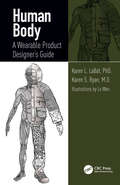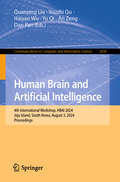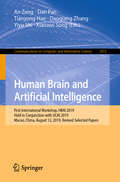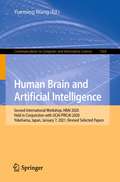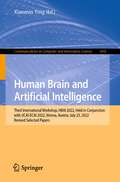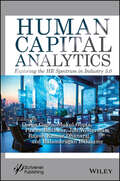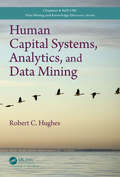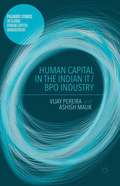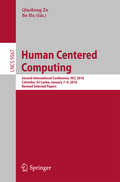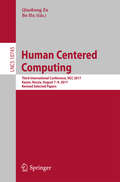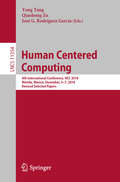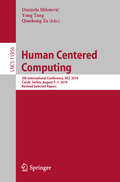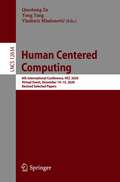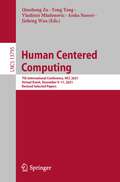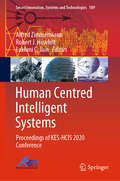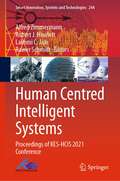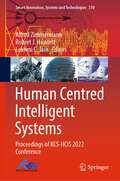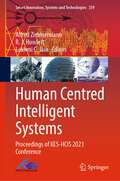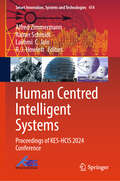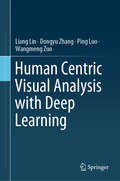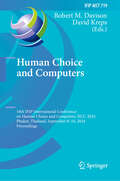- Table View
- List View
Human Attention in Digital Environments
by Claudia RodaDigital systems, such as phones, computers and PDAs, place continuous demands on our cognitive and perceptual systems. They offer information and interaction opportunities well above our processing abilities, and often interrupt our activity. Appropriate allocation of attention is one of the key factors determining the success of creative activities, learning, collaboration, and many other human pursuits. This book presents research related to human attention in digital environments. Original contributions by leading researchers cover the conceptual framework of research aimed at modelling and supporting human attentional processes, the theoretical and software tools currently available, and various application areas. The authors explore the idea that attention has a key role to play in the design of future technology and discuss how such technology may continue supporting human activity in environments where multiple devices compete for people's limited cognitive resources.
Human Behavior Analysis: Sensing and Understanding
by Zhu Wang Zhiwen YuOver the last decade, there has been a growing interest in human behavior analysis, motivated by societal needs such as security, natural interfaces, affective computing, and assisted living. However, the accurate and non-invasive detection and recognition of human behavior remain major challenges and the focus of many research efforts. Traditionally, in order to identify human behavior, it is first necessary to continuously collect the readings of physical sensing devices (e.g., camera, GPS, and RFID), which can be worn on human bodies, attached to objects, or deployed in the environment. Afterwards, using recognition algorithms or classification models, the behavior types can be identified so as to facilitate advanced applications. Although such traditional approaches deliver satisfactory performance and are still widely used, most of them are intrusive and require specific sensing devices, raising issues such as privacy and deployment costs. In this book, we will present our latest findings on non-invasive sensing and understanding of human behavior. Specifically, this book differs from existing literature in the following senses. Firstly, we focus on approaches that are based on non-invasive sensing technologies, including both sensor-based and device-free variants. Secondly, while most existing studies examine individual behaviors, we will systematically elaborate on how to understand human behaviors of various granularities, including not only individual-level but also group-level and community-level behaviors. Lastly, we will discuss the most important scientific problems and open issues involved in human behavior analysis.
Human Behavior Learning and Transfer
by Yangsheng Xu Ka Keung C. LeeBridging the gap between human-computer engineering and control engineering, Human Behavior Learning and Transfer delineates how to abstract human action and reaction skills into computational models. The authors include methods for modeling a variety of human action and reaction behaviors and explore processes for evaluating, optimizing, and trans
Human Behavior Understanding
by Albert Ali Salah Diane J. Cook Ben J.A. KröseThis book constitutes the proceedings of the 6th International Workshop on Human Behavior Understanding, HBU 2015, held in Osaka, Japan, in September 2015. The 11 full papers were carefully reviewed and selected from 15 initial submissions. They are organized in topical sections named: interaction with elderly, learning behavior patterns, and mobile solutions.
Human Body: A Wearable Product Designer's Guide
by Karen L. LaBat Karen S. RyanHuman Body: A Wearable Product Designer's Guide, unlike other anatomy books, is divided into sections pertinent to wearable product designers. Two introductory chapters include many definitions, an introduction to anatomical terminology, and brief discussions of the body's systems, setting the stage for the remaining chapters. The book is extensively referenced and has a large glossary with both anatomical and design terms making it maximally useful for interdisciplinary collaborative work. The book includes 200 original illustrations and many product examples to demonstrate relationships between wearable product components and anatomy. Exercises introduce useful anatomical, physiological, and biomechanical concepts and include design challenges. Features Includes body region chapters on head and neck, upper torso and arms, lower torso and legs, the mid-torso, hands, feet, and a chapter on the body as a whole Contains short sections on growth and development, pregnancy, and aging as well as sections on posture, gait, and designing total body garments Describes important regional muscles and their actions as well as joint range of motion (ROM) definitions and data with applications to designing motion into wearable products Presents appendices correlating to each body region’s anatomy with instructions for landmarking and measuring the body, a valuable resource for a lifetime of designing
Human Brain and Artificial Intelligence: 4th International Workshop, HBAI 2024, Jeju Island, South Korea, August 3, 2024, Proceedings (Communications in Computer and Information Science #2438)
by An Zeng Dan Pan Quanying Liu Youzhi Qu Haiyan Wu Yu QiThis book constitutes the refereed proceedings of the 4th International Workshop on Human Brain and Artificial Intelligence, HBAI 2024, held in Jeju Island, South Korea, on August 3, 2024.The 24 full papers and 5 short papers included in this book were carefully reviewed andselected from 74 submissions. They were organized in topical sections as follows: AI for brain science; AI for brain technology; and brain-inspired AI.
Human Brain and Artificial Intelligence: First International Workshop, HBAI 2019, Held in Conjunction with IJCAI 2019, Macao, China, August 12, 2019, Revised Selected Papers (Communications in Computer and Information Science #1072)
by Daoqiang Zhang Tianyong Hao An Zeng Dan Pan Yiyu Shi Xiaowei SongThis book constitutes the refereed proceedings of the workshop held in conjunction with the 28th International Conference on Artificial Intelligence, IJCAI 2019, held in Macao, China, in August 2019: the First International Workshop on Human Brain and Artificial Intelligence, HBAI 2019. The 24 full papers presented were carefully reviewed and selected from 62 submissions. The papers are organized according to the following topical headings: computational brain science and its applications; brain-inspired artificial intelligence and its applications.
Human Brain and Artificial Intelligence: Second International Workshop, HBAI 2020, Held in Conjunction with IJCAI-PRICAI 2020, Yokohama, Japan, January 7, 2021, Revised Selected Papers (Communications in Computer and Information Science #1369)
by Yueming WangThis book constitutes the refereed proceedings of the Second International Workshop on Human Brain and Artificial Intelligence, HBAI 2020, held in conjunction with IJCAI-PRICAI 2020, Kyoto, Japan, in January 2021. Due to the COVID-19 pandemic HBAI 2020 was held in the year 2021 and transferred into virtual format. The 11 full papers presented were carefully reviewed and selected from 12 submissions. The papers present most recent research in the fields of brain-inspired computing, brain-machine interfaces, computational neuroscience, brain-related health, neuroimaging, cognition and behavior, learning, and memory, neuron modulation, and closed-loop brain stimulation.
Human Brain and Artificial Intelligence: Third International Workshop, HBAI 2022, Held in Conjunction with IJCAI-ECAI 2022,Vienna, Austria, July 23, 2022, Revised Selected Papers (Communications in Computer and Information Science #1692)
by Xiaomin YingThis book constitutes the refereed proceedings of the Third International Workshop on Human Brain and Artificial Intelligence, HBAI 2022, held in conjunction with IJCAI-ECAI 2022, Vienna, Austria, on July 23, 2022. The 19 full papers presented were carefully reviewed and selected from 21 submissions. The papers present most recent research in the fields of brain-inspired computing, brain-machine interfaces, computational neuroscience, brain-related health, neuroimaging, cognition and behavior, learning, and memory, neuron modulation, and closed-loop brain stimulation.
Human Capital Analytics: Exploring the HR Spectrum in Industry 5.0
by Pawan Budhwar Jim Westerman Balamurugan Balusamy Rajesh Kumar Dhanaraj Deepa Gupta Mukul GuptaThe book equips readers with essential insights and strategies for leveraging cutting-edge technology and human capital analytics, ensuring organizations thrive in the era of human-robot collaboration and sustainable workforce development. Human Capital Analytics: Exploring the HR Spectrum in Industry 5.0 provides a comprehensive investigation into the ever-changing junction of human capital and cutting-edge technology in the context of the Fifth Industrial Revolution. This volume emphasizes the revolutionary role that human capital analytics plays in changing workforce management, talent development, and HR strategies. This position is particularly relevant as organizations transition into Industry 5.0, where human-robot collaboration is the norm. The purpose of this book is to provide a forward-looking perspective on how data-driven human resource strategies will become vital for boosting worker potential and driving organizational success. This is accomplished by integrating developing technologies such as artificial intelligence, machine learning, and robots. Readers will find that this book: Explores the transformative role of human-robot collaboration, emerging technologies, and strategic HR planning in the context of the Fifth Industrial Revolution; Provides a comprehensive overview of how predictive analytics and human capital analytics can enhance workforce management, employee engagement, and performance measurement; Focuses on how HR 5.0 contributes to advancing the United Nations Sustainable Development Goals, driving both social and business impact; Includes empirical studies, case studies, and real-world examples of implementing Industry 5.0 in organizations; Provides actionable strategies for HR professionals to navigate the digital transformation of human resource management, incorporating AI, robotics, and data-driven approaches. Audience Human resource developers, analysts, professionals, business executives, data scientists, consultants, professors, academics, and students exploring ways to leverage technology for Industry 5.0.
Human Capital Systems, Analytics, and Data Mining (Chapman & Hall/CRC Data Mining and Knowledge Discovery Series)
by Robert C. HughesHuman Capital Systems, Analytics, and Data Mining provides human capital professionals, researchers, and students with a comprehensive and portable guide to human capital systems, analytics and data mining. The main purpose of this book is to provide a rich tool set of methods and tutorials for Human Capital Management Systems (HCMS) database modeling, analytics, interactive dashboards, and data mining that is independent of any human capital software vendor offerings and is equally usable and portable among both commercial and internally developed HCMS. The book begins with an overview of HCMS, including coverage of human resource systems history and current HCMS Computing Environments. It next explores relational and dimensional database management concepts and principles. HCMS Instructional databases developed by the Author for use in Graduate Level HCMS and Compensation Courses are used for database modeling and dashboard design exercises. Exciting knowledge discovery and research Tutorials and Exercises using Online Analytical Processing (OLAP) and data mining tools through replication of actual original pay equity research by the author are included. New findings concerning Gender Based Pay Equity Research through the lens Comparable Worth and Occupational Mobility are covered extensively in Human Capital Metrics, Analytics and Data Mining Chapters.
Human Capital in the Indian IT/BPO Industry
by Vijay Pereira Ashish MalikHuman Capital in the Indian IT / BPO Industry analyses human capital management in the Indian information technology (IT) and business process outsourcing (BPO) industry, which has created a new paradigm for organising global talent engaged in designing and delivering IT and BPO services. The authors explore the evolution of the innovative talent management strategies of knowledge workers, which has received little attention in existing literature analysis. This book provides a rich theoretical grounding of managing human resources in the context of high-technology professional services firms, focusing on the design and implementation of high performance work system designs in the context of Indian IT/BPO organizations.
Human Centered Computing
by Bo Hu Qiaohong ZuThis book constitutes revised selected papers from thethoroughly refereed proceedings of the Second International Human CenteredComputing Conference, HCC 2016, that consolidated and further develops thesuccessful ICPCA/SWS conferences on Pervasive Computing and the NetworkedWorld, and which was held in Colombo, Sri Lanka, in January 2016. The 58 full papers and 30 short papers presented in thisvolume together with one keynote talk were carefully reviewed and selected from211 submissions. These proceedings present research papers investigating into avariety of aspects towards human centric intelligent societies. They cover thecategories: infrastructure and devices; service and solution; data andknowledge; and community.
Human Centered Computing
by Bo Hu Qiaohong ZuThis book constitutes revised selected papers from the thoroughly refereed proceedings of the Third International Human Centered Computing Conference, HCC 2017, that consolidated and further develops the successful ICPCA/SWS conferences on Pervasive Computing and the Networked World, and which was held in Kazan, Russia, in August 2017. The 48 full and 20 short papers presented in this book together with 2 invited keynotes were carefully reviewed and selected from numerous submissions. This proceedings present recent advances in human machine interfaces, wireless and mobile network technologies, and data analytics, which make computer services truly human-centric.
Human Centered Computing: 4th International Conference, HCC 2018, Mérida, Mexico, December, 5–7, 2018, Revised Selected Papers (Lecture Notes in Computer Science #11354)
by Qiaohong Zu Yong Tang José G. Rodríguez GarcíaThis book constitutes thoroughly reviewed, revised and selected papers from the 4th International Conference on Human Centered Computing, HCC 2018, held in Merida, Mexico, in December 2018. The 50 full and 18 short papers presented in this volume were carefully reviewed and selected from a total of 146 submissions. They focus on a "hyper-connected world", dealing with new developments in artificial intelligence, deep learning, brain-computing, etc.
Human Centered Computing: 5th International Conference, HCC 2019, Čačak, Serbia, August 5–7, 2019, Revised Selected Papers (Lecture Notes in Computer Science #11956)
by Qiaohong Zu Yong Tang Danijela MiloševićThis book constitutes thoroughly reviewed, revised and selected papers from the 5th International Conference on Human Centered Computing, HCC 2019, held in Čačak, Serbia, in August 2019. The 48 full and 23 short papers presented in this volume were carefully reviewed and selected from a total of 133 submissions. The papers focus on deep learning and its applications on a variety of real-life problems, ranging from image/video analysis, to human-computer interaction, and to logistics and supply chain management.
Human Centered Computing: 6th International Conference, HCC 2020, Virtual Event, December 14–15, 2020, Revised Selected Papers (Lecture Notes in Computer Science #12634)
by Qiaohong Zu Yong Tang Vladimir MladenovićThis book constitutes thoroughly reviewed, revised and selected papers from the 6th International Conference on Human Centered Computing, HCC 2020, held in virtually, due to COVID- 19, in December 2020. The 28 full and 20 short papers presented in this volume were carefully reviewed and selected from a total of 133 submissions.The conference focuses on the following three main themes as follows: Data such as Data Visualization, Big Data, Data Security, Hyper connectivity such as Internet of Things, Cloud Computing, Mobile Network and Collaboration such as Collective Intelligence, Peer Production, Context Awareness and much more.
Human Centered Computing: 7th International Conference, HCC 2021, Virtual Event, December 9–11, 2021, Revised Selected Papers (Lecture Notes in Computer Science #13795)
by Qiaohong Zu Yong Tang Vladimir Mladenovic Aisha Naseer Jizheng WanThis book constitutes thoroughly reviewed, revised and selected papers from the 7th International Conference on Human Centered Computing, HCC 2021, held in virtually, due to COVID- 19, in December 2021. The 18 full and 9 short papers presented in this volume were carefully reviewed and selected from a total of 68 submissions. The conference focuses on the following three main themes as follows: Data such as Data Visualization, Big Data, Data Security, Hyper connectivity such as Internet of Things, Cloud Computing, Mobile Network and Collaboration such as Collective Intelligence, Peer Production, Context Awareness and much more.
Human Centred Intelligent Systems: Proceedings of KES-HCIS 2020 Conference (Smart Innovation, Systems and Technologies #189)
by Lakhmi C. Jain Robert J. Howlett Alfred ZimmermannThis book highlights new trends and challenges in intelligent systems, which play an important part in the digital transformation of many areas of science and practice. It includes papers offering a deeper understanding of the human-centred perspective on artificial intelligence, of intelligent value co-creation, ethics, value-oriented digital models, transparency, and intelligent digital architectures and engineering to support digital services and intelligent systems, the transformation of structures in digital businesses and intelligent systems based on human practices, as well as the study of interaction and the co-adaptation of humans and systems. All papers were originally presented at the International KES Conference on Human Centred Intelligent Systems 2020 (KES HCIS 2020), held on June 17–19, 2020, in Split, Croatia.
Human Centred Intelligent Systems: Proceedings of KES-HCIS 2021 Conference (Smart Innovation, Systems and Technologies #244)
by Lakhmi C. Jain Robert J. Howlett Rainer Schmidt Alfred ZimmermannThis book highlights new trends and challenges in intelligent systems, which play an essential part in the digital transformation of many areas of science and practice. It includes papers offering a deeper understanding of the human-centred perspective on artificial intelligence, of intelligent value co-creation, ethics, value-oriented digital models, transparency, and intelligent digital architectures and engineering to support digital services and intelligent systems, the transformation of structures in digital business and intelligent systems based on human practices, as well as the study of interaction and co-adaptation of humans and systems. All papers were originally presented at the International KES Conference on Human Centred Intelligent Systems 2021 (KES HCIS 2021) held on June 14–16, 2021 in the KES Virtual Conference Centre.
Human Centred Intelligent Systems: Proceedings of KES-HCIS 2022 Conference (Smart Innovation, Systems and Technologies #310)
by Lakhmi C. Jain Robert J. Howlett Alfred ZimmermannThe volume includes papers presented at the International KES Conference on Human Centred Intelligent Systems 2022 (KES HCIS 2022), held in Rhodes, Greece on June 20–22, 2022. This book highlights new trends and challenges in intelligent systems, which play an important part in the digital transformation of many areas of science and practice. It includes papers offering a deeper understanding of the human-centred perspective on artificial intelligence, of intelligent value co-creation, ethics, value-oriented digital models, transparency, and intelligent digital architectures and engineering to support digital services and intelligent systems, the transformation of structures in digital businesses and intelligent systems based on human practices, as well as the study of interaction and the co-adaptation of humans and systems.
Human Centred Intelligent Systems: Proceedings of KES-HCIS 2023 Conference (Smart Innovation, Systems and Technologies #359)
by Lakhmi C. Jain Alfred Zimmermann R. J. HowlettThe volume includes papers presented at the International KES Conference on Human Centred Intelligent Systems 2023 (KES HCIS 2023), held in Rome, Italy on June 14–16, 2023. This book highlights new trends and challenges in intelligent systems, which play an important part in the digital transformation of many areas of science and practice. It includes papers offering a deeper understanding of the human-centred perspective on artificial intelligence, of intelligent value co-creation, ethics, value-oriented digital models, transparency, and intelligent digital architectures and engineering to support digital services and intelligent systems, the transformation of structures in digital businesses and intelligent systems based on human practices, as well as the study of interaction and the co-adaptation of humans and systems.
Human Centred Intelligent Systems: Proceedings of KES-HCIS 2024 Conference (Smart Innovation, Systems and Technologies #414)
by Lakhmi C. Jain Rainer Schmidt Alfred Zimmermann R. J. HowlettThe volume includes papers presented at the International KES Conference on Human Centred Intelligent Systems 2024 (KES HCIS 2024), held in Madeira, Portugal on June 19–21, 2024. This book highlights new trends and challenges in intelligent systems, which play an important part in the digital transformation of many areas of science and practice. It includes papers offering a deeper understanding of the human-centred perspective on artificial intelligence, of intelligent value co-creation, ethics, value-oriented digital models, transparency, and intelligent digital architectures and engineering to support digital services and intelligent systems, the transformation of structures in digital businesses and intelligent systems based on human practices, as well as the study of interaction and the co-adaptation of humans and systems.
Human Centric Visual Analysis with Deep Learning
by Wangmeng Zuo Liang Lin Dongyu Zhang Ping LuoThis book introduces the applications of deep learning in various human centric visual analysis tasks, including classical ones like face detection and alignment and some newly rising tasks like fashion clothing parsing. Starting from an overview of current research in human centric visual analysis, the book then presents a tutorial of basic concepts and techniques of deep learning. In addition, the book systematically investigates the main human centric analysis tasks of different levels, ranging from detection and segmentation to parsing and higher-level understanding. At last, it presents the state-of-the-art solutions based on deep learning for every task, as well as providing sufficient references and extensive discussions. Specifically, this book addresses four important research topics, including 1) localizing persons in images, such as face and pedestrian detection; 2) parsing persons in details, such as human pose and clothing parsing, 3) identifying and verifying persons, such as face and human identification, and 4) high-level human centric tasks, such as person attributes and human activity understanding. This book can serve as reading material and reference text for academic professors / students or industrial engineers working in the field of vision surveillance, biometrics, and human-computer interaction, where human centric visual analysis are indispensable in analysing human identity, pose, attributes, and behaviours for further understanding.
Human Choice and Computers: 16th IFIP International Conference on Human Choice and Computers, HCC 2024, Phuket, Thailand, September 8–10, 2024, Proceedings (IFIP Advances in Information and Communication Technology #719)
by David Kreps Robert M. DavisonThis book constitutes the refereed proceedings of the 16th IFIP International Conference on Human Choice and Computers, HCC 2024, held in Phuket, Thailand, during September 8–10, 2024. The 9 full papers presented in this book were carefully reviewed and selected from 17 submissions. Summaries of 2 keynote presentations are also included. This papers focus on Humans, Technological Innovations and Artificial Intelligence: Opportunities and Consequences.

